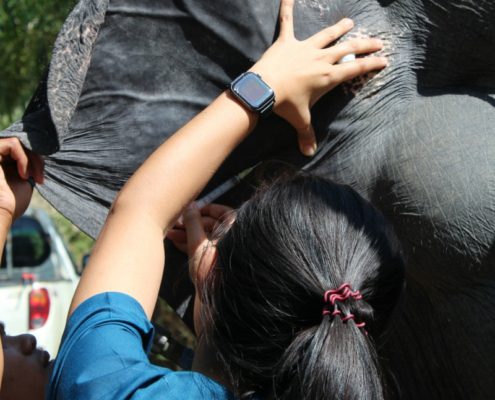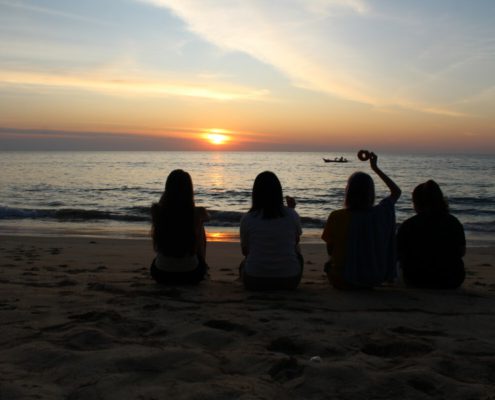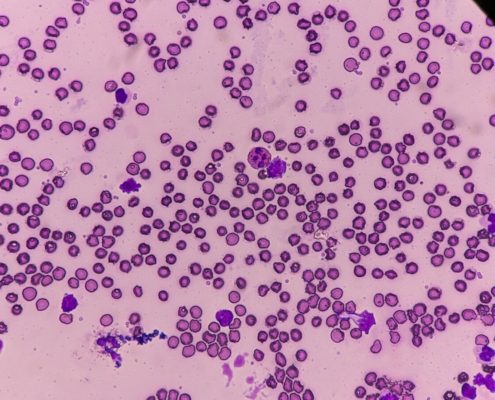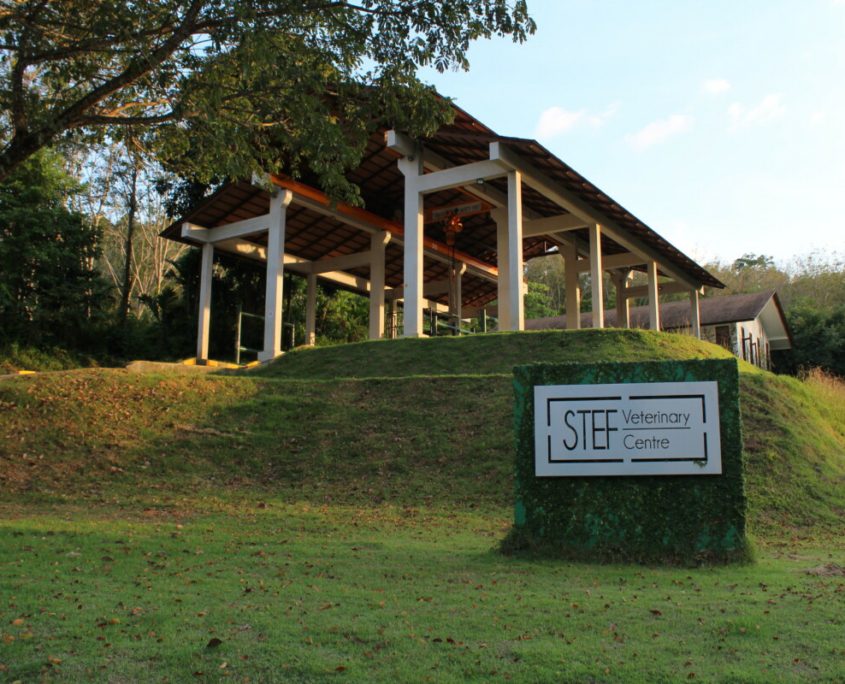My 6 Weeks as an Elephant Vet
A blog by Vanessa Klabouch, Vet Student at TiHo Hannover
01.01.23
Our journey to the Southern Thailand Elephant Foundation vet centre was quite an adventure in itself… As soon as we left the town of Khok Kloi, we were travelling through jungle. Beautiful, almost untouched nature, and there, right in the middle of it all, was the hospital.
I couldn’t have received a warmer welcome (the weather played its part as well).
First, we made a tour of the site and were told where everything is located. Everything here is new and shiny, medical equipment of a high standard and the private rooms, including the kitchen, bathroom, and bedrooms are impeccable. Cosy and familiar but enough space to spread out.
After settling in, we went to lunch, a typical Thai lunchtime cuisine and absolutely delicious. Dinner was also traditional, with shared dishes placed in the middle so that everyone can try everything. I particularly like that. I think you just have to try everything while travelling, especially if the locals show you how to do it properly.
All in all, a super first evening with many interesting conversations! Ready for bed to get enough sleep in order to be alert for tomorrow’s elephant health check… but before I can sleep I need to consider what an elephant health check consists of…..
To start with you need to know something about the physiological behaviour and appearance of elephants. First, observe the animal from afar. The elephant should be in motion, calm but attentive, with ears, trunk, and tail in movement. Make sure that all limbs are cast evenly and note if there is any asymmetry. The respiratory rate should be between 4 and 12 per minute. Check the body condition – is the elephant too skinny or too fat. Ask the owner about his elephant’s appetite. Check the urine and dung. The urine should be light yellow with a pleasant odour, and the faeces well formed but their colour depends on the elephant’s diet. When the elephant is well hydrated you can see a wet line on the base of its nails. After approaching the elephant, check the pulse rate first, because this can change due to the excitement of the health check. Normal is 25-30 beats per minute. The body temperature should be around 36-37°C. Eyes clear and bright, mouth and tongue pink, the tip of the trunk moist.
Right, off to sleep now!
02.01.23
Here we go, the first morning. I have been waiting for this way too long! Of course, I got a little bit nervous and couldn’t sleep last night (as you read above), so I went to the kitchen, where I was welcomed by a big smile from Pi Nong, the cook, who anticipates your every wish. Toast, muesli, eggs, sausage, or “khao thom Gai” (a chicken rice soup) …whatever your heart desires for breakfast. After that, I quickly had to get ready.
First of all, we started to prepare the medicine which we would need for the mobile clinic, placed everything in the car and off we went. We drove to an elephant camp in the Song Prake for an all-round check-up.
Here, they keep 11 elephants, male and female, in different age groups for tourist riding. Every elephant got examined extensively and blood samples were taken. Usually the Venae auriculares are used for this, which are particularly easy to see at the current temperatures. You could also feel the difference between artery and vein very well.
Technically you could also take blood from the Vena cephalica antebrachii on the medial front leg, V. Saphena interna medial on the hind leg, and the Vena centralis caudalis on the underside of the tail. However, the most practical is the ear vein, as this can be easily jammed with one finger and blood drawn with the other.
In addition, it helps that the animals are also used to being touched on the ear, whereas the legs of untrained patients represent a risk for the veterinarian, and the tail and the area directly between the eyes represent a blind spot. Not every elephant will be okay with not seeing what strange things you are doing to it!
Then we gave intramuscular supplements in the Trapezius and every mahout was given a sachet with deworming agent and vitamins. Everything must be given in doses according to the elephant’s weight. For example, a 3,000kg animal gets 23 pills Albendazole (400mg).
The treatments got a bit exciting when a young bull didn’t feel like going to the vet and chased us away, flapping his ears and swinging his trunk. So everyone had to run. The mahouts were able to calm him down again, but the power of these gentle giants should never be underestimated while working with them hands-on.
03.01.23
Today started quietly. After a delicious breakfast with a short lesson about what my food is called in Thai, we had a pharma lesson afterward. We go through all the drugs, and note their composition and use. I found it quite astonishing that, despite the large number of elephants in Southeast Asia, there are no preparations specifically for elephants – most are intended for cattle, horses and pigs. For many preparations, there are lists of which dosage is appropriate for which weight class.
By the way, the weight of the adult Elephas maximus indicus ranges from approx. 2,000 to 5,500kg.
With the use of medicine in which weight is not the only mean of calculating the dosage, you have to be aware that elephants have a low metabolic rate compared to smaller mammals such as a horse. For example, when immobilising a wild elephant, the dose per kg bodyweight should be just 25% of the dose for a horse.
After lunch, we started our tour.
First, we went to see Chana, a female elephant in the Phang Nga Elephant Park, who, according to her mahout, has been eating a lot of soil and showing symptoms of pain. But how does an elephant express pain or, more precisely, abdominal pain in this case?
Visible colic symptoms are the typical signals of GI symptoms, such as loss of appetite, fatigue or restlessness, and a bloated stomach. But also, something like pressing the head against a tree, biting the tip of the trunk, or touching the stomach with the trunk, and standing with legs apart.
When we arrived, Chana was already standing in her enclosure with her head leaning against a post and her legs apart. After a general check from the distance, Dr. Aon first took blood, checked both sides of the abdomen for the presence of intestinal sounds (present in both sites), which provides information about the presence or absence of intestinal motility. Dr Aon then administered her medication, which works as an anti-inflammatory, antipyretic and reduces pain.
Curious Sak Thong
After Phang Nga Elephant Park, we had to drive to Sak Thong, to check up on a logging elephant that collapsed in November. At that time, fluid was provided,, blood taken and vitamins were administered. The Creatinine level was increased in the blood sample, but this can have numerous causes, such as muscular, like muscle damage, which can be influenced by inflammation, trauma, degeneration, but also by hard work in combination with the high temperatures and lack of water. So the cause of weakness can never be clearly assessed, but in this case, a mixture of over-exertion, heat, and dehydration is most likely.
Today blood was taken again to check and supplements were given. However, the patient appeared fresh today, had gained weight, and is still being given some rest by his mahout. He greeted us happily and enjoyed the attention.
The last visit for today was to see four tracking/tourist elephants in Kapong near Khao Sok National Park. The four ladies were all subjected to a general examination.
By the way, reading the chip and recording general data such as name, age, and weight is also included here in Thailand: as with our four-legged friends at home, elephants also have to be chipped! In addition, blood was taken again, supplements, deworming and vitamins were administered.
On one elephant we noticed cracks in the toenails of her hind legs. The cause of these cracks is not fully known but can be related to many factors such as diet, stress, soil conditions, or trauma. Since this animal was previously used in logging, a connection with the heavy physical work at that time is conceivable. This problem will be treated by the mahout this time who has to cut out the crack with a hoof knife.
More information on foot health can be found, for example, in the book Biology, Medicine and Surgery of Elephants (CHAPTER 20 FOOT DISORDERS)
04.01.23
Today was supposed to be a Lab-day, but unexpectedly another case came in – an elephant with diarrhoea. So we grabbed our equipment, and jumped in the car.
After a short drive we had to change to a four-wheel drive car because we would be going up the mountain. We met the mahout with his off-road vehicle and followed him up a very steep road, which was fine at first, but then the tarred road stopped and it became a mixture of rain trickles, stones, and holes, and we kept going uphill.
We went through a river and then up the last steep stretch of mountain. The whole thing looked more like a hiking trail really, and we had to hold ourselves onto the back seat as we went over the bumps. The first attempt didn’t work, so we went back down to attempt the whole thing again.
It was a wild jolt and Dr Aon started sweating more with each try. The car kept stopping at the same point; it was too steep. On the third attempt it finally worked, and we were able to continue our journey in the direction of the patient.
When we reached him at last, everyone was relieved, but I was already thinking that we would have to drive back down this mountain again later……
Off-road to see Michael
Our patient was an adult male elephant. The mahout had him well under control, so Dr. Aon could start right away. After a general examination, blood was taken and a venous access was placed to substitute fluid. This is also done in an auricular vein.
It was exciting to see something like this in the field instead of clinical conditions. First, the elephant was tied to a tree, which had to be strong enough to keep him there, but also had to have suitable branches to attach the infusion to. For that, a rope was thrown over the branch and the infusion was then pulled up on it. You have to be creative with an animal this big in the field.
Vitamin B, antibiotics, and anti-inflammatory painkillers were administered. The owner was then given antidiarrheal and antiflatulent medicine to administer for the next six days. Before we left we took a faeces sample and checked it optically and olfactorily. It smelled intense and already stank from far away. Not the typical grass smell that healthy elephant dung has.
If you want to know more about this topic: https://southernthailandelephants.org/elephant-colic/
Now we had to go all the way back down the track again. The best part was to watch Den, our mahout, who was standing in the back of the truck holding on. We had to keep checking to see if he was still standing there or had been thrown off! On the way back home we stopped to get some food and, of course, it was amazing, especially the dessert this time. I highly recommend trying “Khanom khrok”. They are like mini pancakes but made with coconut milk.
05.01.23
Today we went to the Phang Nga elephant park to study the behaviour and body language of elephants a little better. Luckily there weren’t that many tourists in the afternoon and we could watch them without being disturbed.
All their Elephants made a calm and attentive impression. Our patient, Chana, from earlier in the week, was well again and seemed happily busy with elephant things. Their main activity was eating of course, but everything else that they thought was exciting also got carefully examined with the trunk. Whether it was the food in their friend’s mouth, or sniffing us from a distance. Of course, the age difference between the animals was also noticeable in the way they played. By the way, one way to recognise their age is by their ears. In young animals the ears stand upright, the older the animal the more the upper edge of the ear folds in. But also, the colour of their skin; young individuals are still very dark, whereas older ones lighter with more and more pink on the forehead, trunk, and ears.
Of course, if you get the chance, you can also determine it based on their teeth. Elephants have 1/0 0/0 3/3 3/3 which means one incisive dens which is the tusk, no canini, and each three premolars and molars, which grow onward throughout life.
Later we went on a little hike with an elephant. It was nice to see how comfortable he felt, grabbing all kinds of plants which he liked the most and stopping for a break whenever he wanted to. In between, he even laid down and rolled in the sand. He didn’t seem to be bothered by us students at all. After the little exertion, he went swimming, which he obviously enjoyed very much.
After seeing all these happy Eles, we went to the sea at the end of the day to enjoy the sunset.
06.01.23
Friday and finally time for a lab day. 18 blood samples had to be streaked and stained. A blood count was made and evaluated and the faecal samples were examined, too.
There are particularly interesting red blood cells in elephants, they have a bulls-eye appearance. The Lymphocytes have a round nucleus and a thin rim of cytoplasm. Heterophils have an irregular, multilobular nucleus, irregular granules and are usually eosinophilic Mononuclear Monocytes have a large kidney shaped nucleus and cytoplasm all around. Elephants naturally have a high Monocyte count (20-40%). Binuclear Monocytes have two nuclei in one large cell, with cytoplasm surrounding them, they are most commonly found and 60-80% of all Monocytes.
Eosinophils have a multilobular nucleus, and the granules in the Cytoplasm are very eosinophilic and uniformly round. Thrombocytes can be found on each smear, in different sizes and numbers per individual, usually 20-60 per field.
07.01.23
We had to visit three patients at Bang Keaw adventure camp this morning. One Elephant had constant discharge from the eyes, profusely tearing watery, clear. We used a Fluorescent eyewash to check for any defect. After controlling with light, a lesion could be seen, but it was difficult to assess how deep it was.
We recommended to bring the elephant to the clinic because eyedrops have to be used at least 4 times a day, over a longer period of time, and no direct sunlight should get into the eye.
To ensure this, professional care in the clinic makes more sense than during their workday and we hope to welcome Boon Nam in the next few days at the clinic.
The second elephant Thong Kam had back problems. It was possible to feel the heat in this area around the spine. These problems can appear due to the hard work over the day and elephants can physiological only carry 10% of their bodyweight. We recommend to keep Thong Kam off from work for some days until it gets better. Painkillers, anti-inflammatory steroids, massage oil for the muscles, and hot compression were prescribed. These had to be slapped at the region to send the heat in with vibration. Did you know that the Skin thickness is 1.9–3.2cm?
The last one at this camp was Kaew, he had an abscess, but got treated by the vet team for a while already. A little bit background story on him: he worked in the logging industry before. The skin around the neck was rubbed because of this and was the cause of the abscess, the whole neck was swollen. Anti-inflammatory medicine was given, and a cold compress on the first two days, afterwards warm ones. For a while, the abscess was gone, but then moved to the shoulder. Because of the thick skin and difficulties to flush and keep it clean, we didn’t break it open and waited for the abscess to erupt by itself instead. It opened two weeks ago, and when we checked today it felt hard and had a little wound where it erupted. We told the owner to keep on cleaning and apply iodide to keep the wound softer.
After lunch back at the hospital, we sat together to discuss a few cases. In order to get some more information on how long-term cases are treated and what kind of possibilities you have.
It was very interesting and if we don’t get to see these cases, at least we know what to do now.
In the evening we kept on talking and talking because it was the last day for Judy and Joyce. We had a lot of fun together and planed on meeting back here again someday.
If you want to take part in our programme, and join the team in Thailand, then you can find out more and book your place by visiting the STEF Thailand website. Look out for next week’s blog from Vanessa.




































